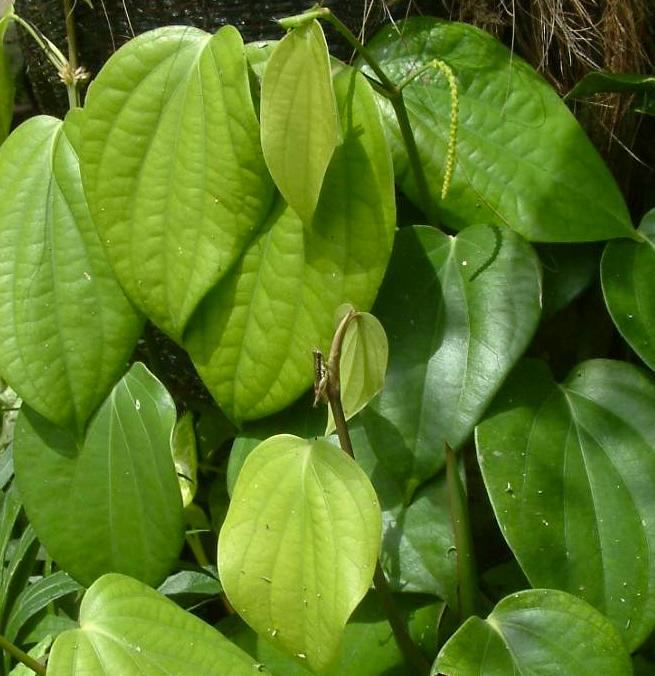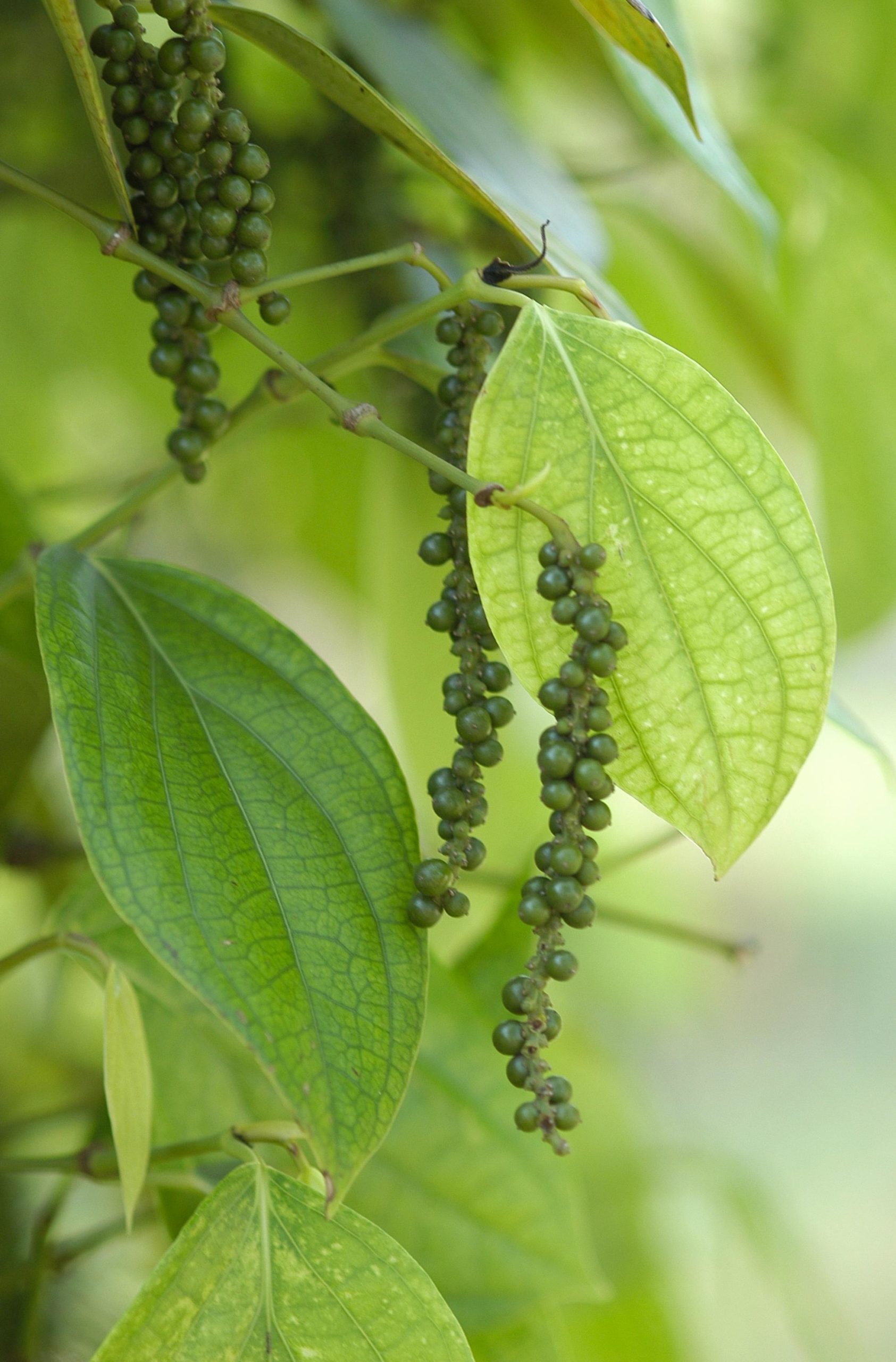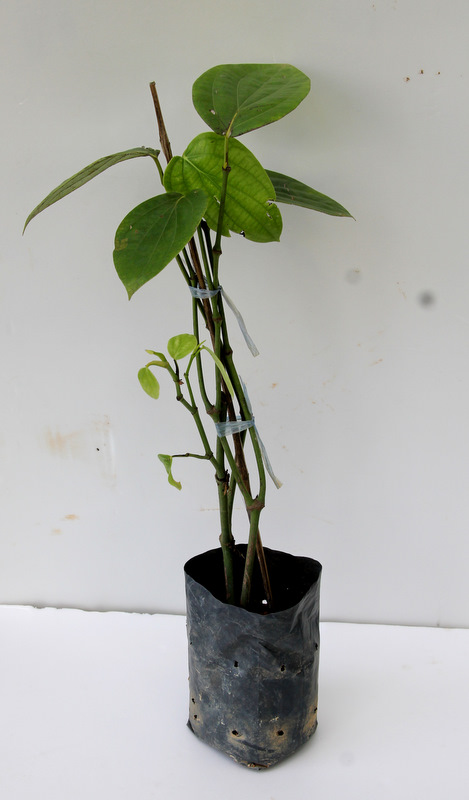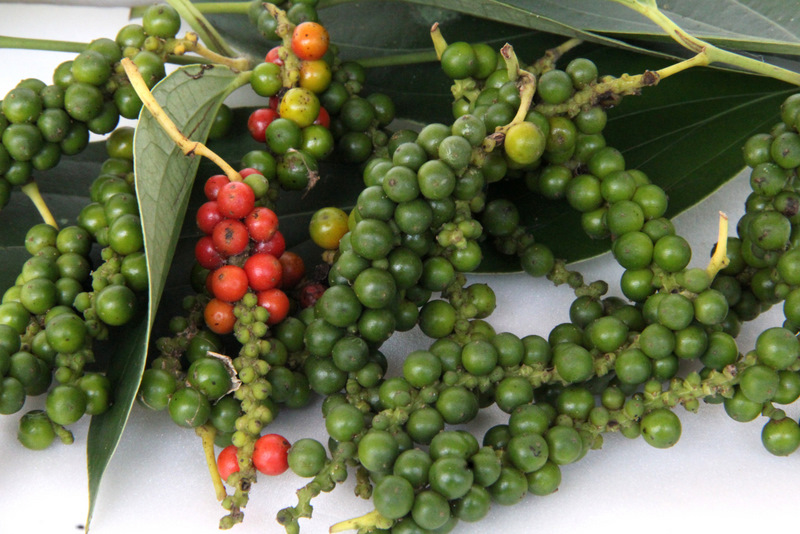Botanical Names
Piper nigrum
Common Names
| Malaysia | Lada hitam |
| English | Pepper, black pepper, white pepper |
| Indonesia | Lada hitam, lada putih, lada sula |
| Thailand | Prik thai |
| India | Gol mirch, gulki, kurumulagu, yavanapriyam |
| China | Hu jiao, hei hu jiao, bai hu jiao, woo jiu |
Family
Piperaceae
Introduction
‘Lada hitam’ (pepper) is the berries of a vine belonging to the Piperaceae family. The plant is native to India. It is now widely cultivated in the tropics worldwide. It is cultivated for its fruit, which is usually dried and used as a spice and seasoning. The world leaders in the world production are Vietnam, India, Indonesia, Brazil, Malaysia, Thailand, Sri Lanka, Madagascar and Mexico.[1][2][3]



Medicinal Properties and Usage
Black pepper has been used to treat a number of ailments such as asthma, cough, heart diseases, throat and other inflammations, urinary disorders, tooth and muscle aches, snake bites, eye diseases and cholera. It is also being used to control worm infestations, an antidote for poisons, as aphrodisiac and enhancing digestions. The roots are used as stomach anaesthetic, muscle relaxant, digestive stimulant and antiseptic.[1]
Soil Suitability and Climatic Requirement
Field Preparation
Pepper vines prefer moist, hot, tropical climates for optimum growth. It requires evenly distributed annual rainfall of about 2,500 mm and grows best on flat or gently sloping land from sea level up to approximately 600 m. Maximum production occurs on deep soils rich in organic matter and medium texture, pH of about 5.5 to 6.0, well drained and good aeration. The plant can tolerate some shade.[1]
Land Preparation
Prior to planting, normal field operations such as land clearing, disc ploughing and rotovation are to be conducted. The disc ploughing is done to prepare the area for liming activity if the pH of the area is low (acid soil). The second ploughing by using rotovator must be carried out after application of the liming material to ensure the material is well incorporated into the soil. Field drainage system should also be established in areas that are easily waterlogged.[1]
Production of Planting Materials
The plant is normally propagated vegetatively by using stolon cuttings selected from the vigorous, healthy and high yielding mother vines. The young stolon obtained from the upper part is preferred. These stolons are firstly sowed into the polybags and kept under shade for about 8 weeks. The seedlings are ready for field planting when the new shoots grow to about 10 cm long.[1]
Field Planting
The recommended planting distance for mono-crops of black pepper is 2.5 m between rows and 2.0 m between plants in the row. This will give the population density of about 2,000 plants/ha. The long planting poles of about 4 m or compatible trees are required as the support for growth. Several cuttings may be planted adjacent to each support. Occasional pruning are carried out to encourage lateral branching and keeps the plant to the required height.[1][4]

Field Maintenance
Fertilisation
Both the organic and inorganic fertilisers are usually applied in pepper cultivation. The organic manure (chicken dung) at the rate of 2-4 t/ha is incorporated into the planting hole about 7 days before planting. The recommended inorganic fertiliser for the established crop is 300 kg N, 100 P2O5 and 300 K2O ha/year. Both fertilisers (organic and inorganic) are divided into 4 equal portions and given at 3-month intervals. Half of these rates are given for the immature plants.[1][5]
Weed Control
The weeds are normally controlled manually by using grass cutters during the initial stages of crop growth. The organic mulch such as dry grasses are given around the planting points to control weeds. The mulch also helps to conserve moisture and reduce the soil temperature, especially during the drier months. Very minimal weed problem is observed when the plants are fully developed.[1]
Water Management
The plant requires constant moist soil, but not water logged for maximum vines growth and yield. Hence, supplementary irrigations should be given during the dry months. The drip irrigation is recommended since it is easier to manage, cheaper and requires less water. Proper drainage systems should be established to avoid flash floods.[1]
Pest and Disease Control
The primary disease problem with black pepper cultivation is root rot and foot rot caused by Phytophthora capsici and stem rot and wilts disease caused Fusarium solani. Symptoms of these diseases include the wilting of leaves and discolouration of stems near the soil line. The main insect pests are stem borer (Lophobaris piperis) and thrips (Leothrips crassipes). Good phytosanitary measures and the proper use of proper pesticides and fungicides could help to control these diseases and pests.[1][6]
Harvesting
First harvest can be done at 3 years after planting. The full potential is realised at 7-8 year from planting and remained most productive until about 20 years of age. The potential yield of fresh berries from fully-grown crop is about 11,200 kg/ha (or 3,100 kg/ha dried). Ripe berries may be picked about 9 months after flowering. Berries ripen over a period of 2–6 months depending on climate. Berries are usually harvested every 7–14 days during the harvesting period.[1]
Postharvest Handling
The berries are harvested when the colour is greenish yellow. It is then dipped in boiling water for about 10 minutes. This provides a surface disinfestation and starts the fermentation process, which turns the berries black. Berries are dried in the sun after the hot water treatment. Depending on the weather, it takes about 14 days of sun drying in order to reduce the moisture to about 12%. Good post harvest handling will help to produce a uniform (brown to back) berries having pungent smell and free from fungal infestations.[1]

Estimated Cost Of Production
The estimated total cost of production for pepper is RM 22,00 per hectare. The cost covers the both the cost of initial development (RM6,500) and crop maintenance (RM 15,500). At the production level of about 3,200 kg/ha, the cost of production for a kilogram of black pepper (dried berries) from the established crop is about RM 4.80 / kg. The cost of production was estimated based on the current inputs cost during writing of this article.[1]
Read More
References
- Abd. Rahman Azmil, I. 2005. Manual Penanaman Lada Menggunakan Pokok Derdap. MARDI : Serdang.
- Mat-Salleh K. and Latiff A. 2002. Tumbuhan Ubatan Malaysia. Kuala Lumpur : Universiti Kebangsaan Malaysia
- Prajapati N. D., Purohit S. S., Sharma A. K., and Kumar T. (2003). A Handbook of Medicinal Plants – A Complete Source Book. Jodhpur : Agrobios (India)
- Abd. Rahman Azmil, I. 1996. Studies on Black pepper Support Systems in Peninsular Malaysia. Journal of Plantation Crops Vol. 24; 1996. Proc. International Symposium on Plantation Crops (PLACROSYM-XI) 30 Nov.-3 Dis. 1994, Calicut, Kerala, India. Kasaragad, Kerala: Indian Society for Plantation Crops
- Abd. Rahman Azmil, I. dan Shukor, N. 1991. Pembajaan untuk tanaman lada di tanah Siri Rengam di Johor. Teknol. Pelbagai Tanaman, MARDI 7: 37-40
- Mohd. Anuar, A. dan Loh, C.F. 1987. Pests and diseases of pepper, Piper nigrum L. In Johore. (MARDI Report No. 118),20 him. Serdang: MARDI


